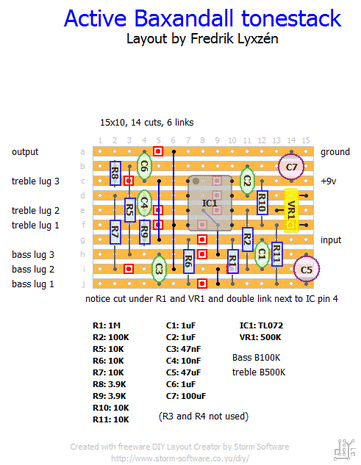|
EDIT 2014-09-29 I added a PCB layout to the bottom of the post. Here's a nice active Baxandall qualizer that I designed. Originally I did a layout for a schematic called "Bax in a box" (google it and you'll find it) that worked ok, but it was just "semi-active". The dual op-amp was just acting as a buffer and a make-up gainstage, so this is my take on an improved truly active version. You can put after your favourite fuzz or whatever, or just in a stand alone box.
13 Comments
Jim
1/25/2015 03:40:03 pm
What does VR1 do?
Reply
1/25/2015 04:43:38 pm
VR1 sets the gain of the first op amp stage and acts like a volume pot. Set the bass and treble controls at noon and use VR1 to match the volume with the bypassed signal. The trimmer could also be replaced with a pot if you want the control outside the box. Recommended if you are using it as a stand alone effect.
Reply
Jim
1/25/2015 11:23:20 pm
Thanks, I can think of a bunch different uses for this.
Juan
4/1/2015 11:36:10 pm
Hello Fredrik,
Reply
4/3/2015 02:02:14 am
Hi Juan
Reply
Brad Hill
4/16/2016 08:21:29 am
Thanks for posting this vero layout! If I want to replace the trimmer with a pot, would the lug designations be: (1=d15, 2=e13, 3=f15) or the other way around (i.e. 1=f15, 2=e13, 3=d15)?
Reply
5/5/2016 01:25:21 pm
Hi Brad,
Reply
Brad Hill
5/5/2016 04:09:51 pm
No problem! Thanks for getting back to me. I actually built the circuit and took a guess on the volume pot. Fortunately, I guessed right and the volume pot works in the familiar "Full Clockwise = Full Volume" when Lug1 connects to d15 and Lug3 connects to f15.
Fernando
6/30/2017 05:11:10 pm
Does it work for bass?
Reply
Jonathon Yi
8/18/2017 09:50:35 am
Great layout! I like how compact it is!
Reply
8/18/2017 10:43:41 am
Hi Jonathon,
Reply
agschaid
1/8/2018 12:18:31 am
Hi there,
Reply
Willy
10/6/2019 11:24:02 pm
Works great! Used it to replace the tone section of a Madbean Boneyard vero.
Reply
Leave a Reply. |
vero layoutsAll the layouts are Verified unless noted. Archives
February 2018
Categories
All
|
||||||

 RSS Feed
RSS Feed